5 Washing Machine Drainage Options: Easy & Fast
Author: Omar Alonso | Editor: Omar Alonso
Review & Research: Jen Worst & Chris Miller

Did you just bring home your new appliance and are now considering the various washing machine drainage options available for your laundry room? Let's dive into the world of washing machine drainage and explore the options available, the materials used, and tips for installing a drainage system.
We'll be sharing expert advice on the best drainage options based on your home's existing infrastructure for water removal. With our guidance, you can ensure that your washing machine's drainage system works at peak performance and keeps your home free from water damage.
5 Washing Machine Drainage Options
There are various washing machine drainage system choices based on the brand and setup of your unit. Every choice has a specific positioning, how it funnels out water waste, and different levels of expensiveness or cost-effectiveness. Here are the various washing machine drainage possibilities below.
Use A Clothing Tub
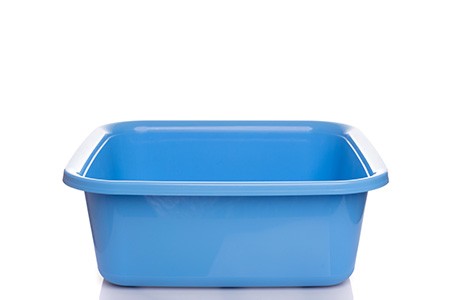
To reassure your washer does not leak, use a clothing tub. All washing machine companies allow for integrating a clothing tub as a washing machine drainage option using the drainage hose.
The channel hose is upwards of 30 inches above ground level. Hence, a clothing tub should be positioned at most 18 inches next to the washer for proper drainage. And if your washing machine ever malfunctions you can use the clothing tub as a washing machine alternative to get your clothes clean still.
Install An Underground Line
If you want to avoid moving your washer to a different location for a long time, an underground line would be a more convenient drainage option, as it will take the dirty wash water beneath the ground for you when it is time for the rinse cycle. The underground line and the waste hose connection will interact to make this occur.
"Remember that, if you live in an apartment block, you will need to speak to the management company or other flat owners if you decide to go ahead with this," suggests Ruban Selvanayagam of Homeowners and Sales Company Property Solvers. Renting only entitles you to certain modifications, and this is not one of them.
Hence, you will have to dig a hole directly into the floor of wherever you are installing the underground line. Be sure to position your washer where you want it to stay for a while because you will have to cover that hole before integrating a new underground line if you plan to move it.
Integrating an underground water line is one of the safer options as it will not cause water logging in your backyard or clogging in your septic tank. If you have the budget you can look into a greywater system as well.
Drain Into a Utility Sink
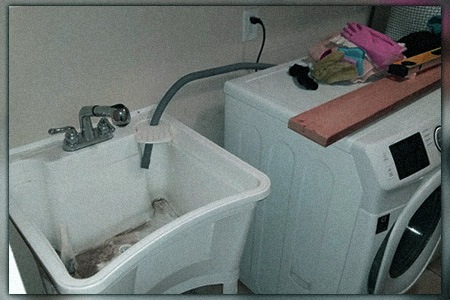
A utility sink is also known as a slop sink. This means the channel hose stays connected to a washbowl, where the water waste from the washing machine funnels once it is time to transition into the rinse cycle. This is your best option from the washing machine drain alternatives because it'll still get rid of the water for you without needing to take it outside.
It is recommended to maintain a sound enough air hole between the end of the channel house and the opening of the washbowl sink to maintain fresh water through the whole wash cycle.
If the utility sink has a sink sifter, check in between washes to be sure it is polished and cleaned regularly. Not doing so can mean flooding the washbowl while draining from the washing machine's channel hose.
Standard Drain Pipe
Rather than wedged into the floor like an underground line, a standard drain pipe sits near the washing machine embedded into the wall. Since these pipes are wider than channel pipes for washing machines on the general market, they can handle funneling out water waste usually faster than other washing machine drainage options.
Utilizing a Freestanding Standpipe
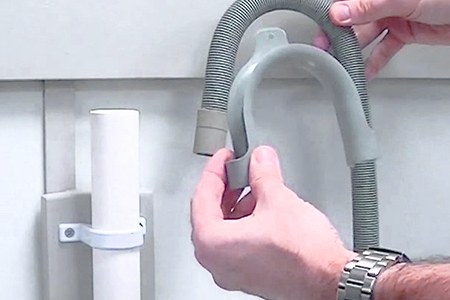
Working with a standpipe is one of the most cost-effective and easy-to-use washing machine drainage options. Get a working standpipe that connects to the waste hose for proper draining. The standpipe is very much like the "standard drain pipe" above and are sometimes embedded in the wall as well.
These are vertically-oriented pipes with a trap at the bottom with a short horizontal run into the waste stack pipe. This provides proper drainage and direct ventilation since the washing machine won't be greater than 5 feet away from the standpipe. This configuration is often used as one of the toilet venting options, too.
The standpipe should have a diameter thick enough so the water waste passes through without hindrance. While you can install a standpipe yourself with common handyperson knowledge, you can enlist the help of a plumber to assist you if you need more clarification. Also, make sure you account for the pipe when making calculations regarding your dryer and washing machine dimensions in your laundry room.
Maintenance Work for Washing Machines
Maintaining your washing machine doesn't have to be a daunting task! You can keep your trusty appliance running smoothly for years with just a little effort. Remember to give it some TLC regularly.
Whether you opt for a DIY approach or call in the professionals, it's essential to check for any clogs or malfunctions in the machine at least once every couple of months. Doing so will ensure that your laundry stays fresh, clean, and smelling sweet.
Install an instant channel from the hardware store made of aluminum (some models are made of nylon) between the connection to the washing machine and the hose channel's end. Customize an instant channel with a pair of repurposed pantyhose or another porous piece of clothing.
Because of installing this instant channel, much of the grime from the water waste will stick to it instead of throughout the entire water waste pipe, which means less cleaning on maintenance day.
What Materials Are Used To Drain Washing Machines?
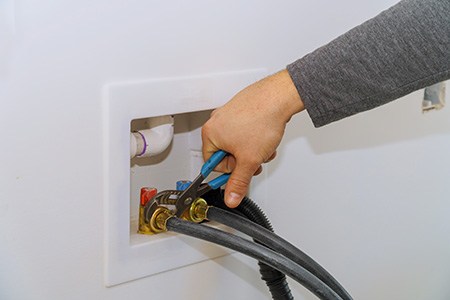
Now that you know about the washing machine drainage hookup options, what materials are usually utilized to see the drainage through to completion?
The two primary materials are an elastic drain hose and a braided drain line made of tempered steel. Each option has its pros and cons with different applications.
Elastic Drain Hose
One material used to drain washing machines are elastic drain hoses. It is one of the choices that has been around longer than the other. Newer models utilized rayon or other strong materials for long-lasting draining capability.
Any of the new models that have the word built-up in the name means that it maintains durability for a longer time than other types on the market.
A Braided Drain Line Made of Tempered Steel
When you think of tempered steel, you may believe it is sturdy and not so flexible to be a washing machine drainage option. However, it is a primarily plastic drainage system with tempered steel wire integrated throughout to enhance the drainage option's strength.
The drainage hose has to be flexible due to the vibrations of the washing machine when spinning. Even if you stop your washing machine from walking around the room, it'll still be vibrating.
These types of hoses have become standard no matter what washing machine drainage options you use. They'll run between your washing machine and your drain pipe and last for an incredibly long time.
Do Washing Machines Drain Into Your Backyard?
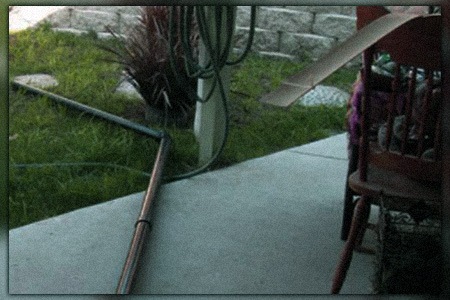
Most washing machine companies will not hook up lines to drain waste water into your backyard. Instead, the drainage options will go into an underground pipe or into a separately attached unit to drain the water accordingly without affecting your backyard.
If your washing machine's wastewater were to drain into your backyard, it could affect your home's foundation via erosion. Your house could start leaning as more erosion influences the foundation, or your home could cave into the ground altogether if the damage is too significant.
Washouts are another possibility. Your backyard's topsoil could become waterlogged. If you have concrete sidewalks or other structures in your backyard, they may have to be replaced if washing machine water waste gets to them.
Plus, your backyard will not look aesthetically pleasing with so many puddles of dirty washing machine water mixed with soapy laundry detergent byproducts.
Do Washing Machines Drain Into Septic Tanks?
Reassure that your washing machine is not draining directly into your septic tank. An average laundry load used to use about 40 gallons of water, though newer high-efficiency (HE) washing machines use between 7 and 13 gallons.
A high amount of water draining into your septic tank at this capacity will cause it to malfunction, whether by getting clogged or becoming defiled from all the dirt and grime extracted from the dirty clothes into the wastewater.
The best, safer alternative for draining your washing machine is to work with a professional plumber to install a greywater system where your washing machine can drain accordingly. Besides your washing machine, you can also connect all your sinks and bathtub water to the system.
How To Properly Hook Up A Washing Machine Drain
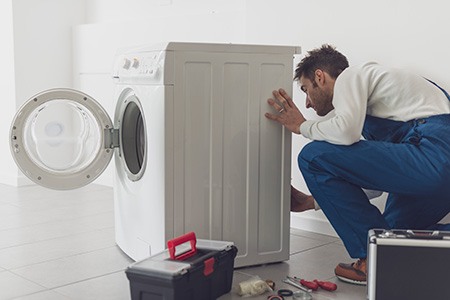
With so many options available, we must learn how to hook up a washing machine drain to remove the wastewater accordingly from the unit during every wash.
Highlighted are the general tips to keep in mind to correctly install a washing machine drain based on different contingencies of what your home may or may not have already:
- If the drainage system you have in place is malfunctioning, you can drain into a backup utility sink in your home.
- Never hook up your washing machine drainage hose into your septic tank or in the direction of your backyard because of the aforementioned warnings and risks of what could happen if you do so.
- Instead of doing it yourself, enlist the help of a professional plumber to hook up a new washing machine drainage hose, create a new greywater system, or update any of these units.
- Consider getting a greywater system for washing machine drainage if your home already runs off of a septic system.
- If your home does not have a septic system, you can drain wastewater from a washing machine directly into your house's connected sewer line.
Ensure that your plumber knows your washing machine's exact make and model, so they know how to integrate your chosen drainage option. If necessary, find the appropriate owner's manual for your washing machine if it gives you more peace of mind during the job.
Those Are Your Washing Machine Drainage Options
What type of washing machine drainage option does your home use as a homeowner? Let us know in the comments to help another fellow homeowner reading this post today.
If you are a professional plumber reading this, weigh in on your tips for the drain installation process. Every piece of input helps a homeowner with these questions to make the best decision for their new washing machine drainage setup. They'll want to know all their washing machine drainage options and have a million questions. Be ready to answer!



